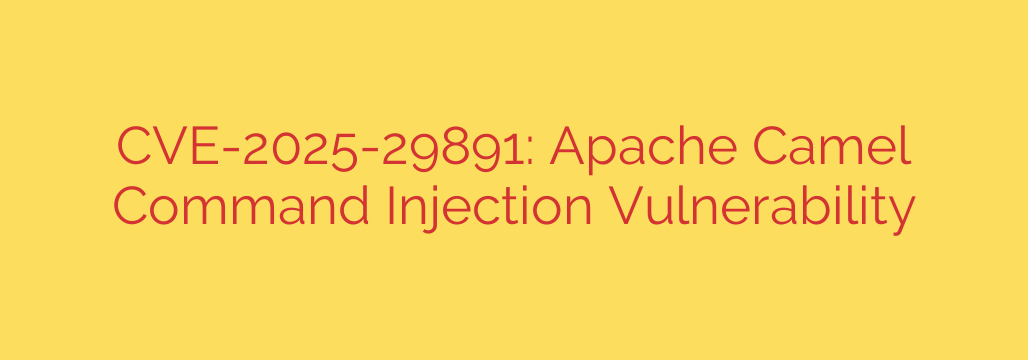
Urgent Security Alert: Critical RCE Vulnerability in Apache Camel (CVE-2025-29891)
A critical security vulnerability has been identified in Apache Camel, a widely-used open-source integration framework. Tracked as CVE-2025-29891, this flaw poses a significant risk of command injection, which could lead to Remote Code Execution (RCE). This means a potential attacker could execute arbitrary commands on the server running a vulnerable application, a worst-case scenario for system security.
This alert is crucial for all developers, DevOps engineers, and security professionals who build or maintain applications using Apache Camel. Immediate action is required to assess your exposure and mitigate the risk.
What is the Apache Camel Vulnerability (CVE-2025-29891)?
At its core, CVE-2025-29891 is a command injection vulnerability. It arises from insufficient input sanitization within specific components of the Apache Camel framework. When an application processes user-supplied data through a vulnerable Camel route, an attacker can craft a malicious input string. Instead of being treated as simple data, this string is interpreted and executed as a system command on the underlying server.
The impact of this vulnerability is severe. Successful exploitation grants an attacker the same level of permission as the user running the application, potentially allowing them to:
- Read, modify, or delete sensitive files.
- Install malware or ransomware.
- Exfiltrate confidential data.
- Use the compromised server to launch further attacks on the internal network.
Essentially, a successful exploit can result in a full system compromise.
How the Vulnerability Works
The flaw exists in how certain Camel components handle external process execution. For instance, components designed to interact with the operating system (like those for executing shell scripts or commands) may inadvertently trust and execute parts of an input message that an attacker controls.
Imagine a route designed to ping a hostname provided by a user. If the input hostname is not properly validated, an attacker could supply a value like 8.8.8.8; rm -rf /tmp/important_data. A vulnerable system might execute the entire string, first pinging the IP address and then executing the malicious command to delete files. This is a simplified example, but it illustrates how easily an unsanitized input can lead to unauthorized command execution.
Any application that uses a vulnerable Apache Camel component and exposes it to user-controllable input is at high risk.
Actionable Steps for Mitigation and Remediation
Protecting your systems from this threat requires immediate and decisive action. Follow these security best practices to secure your applications.
1. Upgrade Your Apache Camel Dependencies Immediately
The most effective way to resolve this vulnerability is to upgrade to a patched version of Apache Camel. The Apache security team has released updates that properly sanitize inputs and close this security hole.
- Identify your current Apache Camel version. Check your project’s
pom.xml,build.gradle, or other dependency management files. - Update to the latest secure version. Check the official Apache Camel project for the latest stable and secure releases that address CVE-2025-29891. Do not delay this process, as attackers often develop exploits quickly after a vulnerability is publicly disclosed.
2. Conduct a Security Audit of Your Camel Routes
Even after patching, it is a good security practice to review your existing code.
- Audit all routes that accept external input. Pay close attention to routes that use components for executing commands, processing files, or evaluating dynamic expressions.
- Enforce strict input validation. Never trust user-supplied data. Implement allowlists for expected values and formats. Reject any input that does not conform to strict rules. This principle of “never trusting user input” is a cornerstone of secure application development.
3. Implement Workarounds if Patching is Delayed
While upgrading is strongly recommended, some organizations may face delays. If you cannot patch immediately, consider these temporary workarounds:
- Disable vulnerable components: If your application does not require the specific component that is vulnerable, disable it in your Camel context.
- Add a validation layer: Implement a robust validation and sanitization layer in your application before data is passed to any Apache Camel route. This can act as a crucial line of defense.
Staying proactive about security is essential. This vulnerability serves as a critical reminder that keeping software dependencies updated is not just a maintenance task—it is a fundamental security requirement. Patching your systems against CVE-2025-29891 should be your top priority.
Source: https://www.offsec.com/blog/cve-2025-29891/








